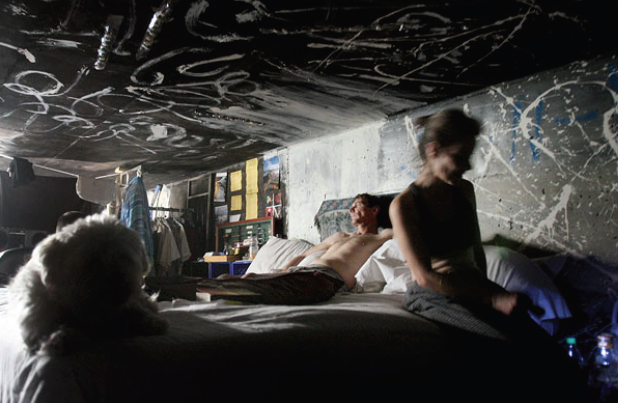The recession has been bad for just about everyone, but it has been much worse for some than others. And surely among those hurt the hardest have been the homeless who have become both the frequent target of hate crimes as well as the aim of criminalization laws in 273 cities nationwide making it making it illegal to eat, sit, or sleep in public places. It is difficulty to fathom the fear that animates such violent reactions against those we might imagine are forlorn and hopeless—what is about such fellow citizens that evokes such animus? what makes them appear to be so undeserving of our charity?— but since it comes from both vigilantes (the rock) and the state (the hard place) we can only assume that it is driven by deeply seeded anxieties.
A photograph featured by the New York Times in a story on efforts to enact hate crime statutes against those who perpetrate violence against the homeless perhaps offers the hint of an answer.
The photograph is of a couple who live in an underground flood channel beneath the Las Vegas strip. The image is shot at eye level, the vertical angle neither high nor low, and thus nullifying any sense of a power differential between the viewer and the subjects even as it suggests some degree of identification; at the same time, however, the horizontal angle is slightly oblique, detaching the viewer from the scene, perhaps even casting him or her as an outside observer. The image is thus framed formally by a tension between identification and dissociation.
The social tension that simultaneously separates and connects viewers and the viewed is marked in other respects as well. The faces of the people are not recognizable, cast in shadows and blurred by movement, and yet they appear to be a normative heterosexual couple—perhaps even a family—as they share their neatly made bed with one another and their dog. It is clearly not a normal house or apartment. Distinguished by its low ceiling it has something of a cellar-like atmosphere, dark and damp. The unrecognizable graffiti strewn across the wall and ceiling makes even that an unlikely location however, suggesting something of a public space. And yet for all of that it does appear to be organized as a private “room” that bears many of the artifacts of modern living, including what looks to be a bulletin board that features colorful photographs—a reminder of or perhaps a hope for better times—and something like a desk. And note too the book that sits next to the man’s leg as he apparently has tired of reading in bed. Maybe he is listening to the boom box that sits behind the dog.
The most telling feature of the photograph is surely the clothing neatly hanging on a rod in the background. This sign of orderliness—here, a clear marker of civility—does not fit with our stereotype of the homeless as crazed, drunken or lazy vagabonds. These are not social outcasts who tote their worldly goods bundled together in a trash bag or orphan grocery cart or who mumble to themselves while walking down the street. They clearly know what it means to have a home. Indeed, these people could be us, the viewers, you and me. And therein, no doubt, lies at least part of the answer to the cause of our intense fear and loathing of the homeless, for as much as scenes like this lead us to utter the mantra “there but for the grace of God,” so too do they heighten the need for dissociation. And as history has shown, time and again, there is no more powerful mode of dissociation than casting about for scapegoats. But that, of course, has not been history’s only lesson with respect to the practice of scapegoating.
Perhaps we too as viewers are caught between a rock and a hard place.
Photo Credit: Isaac Brekken/New York Times

I’ve linked to this moving essay on my blog about photography at http://jonathan-morse.blogspot.com. Of course, the most straightforward way to think through your generalization from the photograph, “It is hard to fathom the fear that animates such violent reactions against those we might imagine are forlorn and hopeless . . . but since it comes from both vigilantes and the state we can only assume that it is driven by deeply seeded anxieties,” is the economic one. This particular picture, for instance, was taken in Las Vegas, a tourist town whose economy depends on vacationers from the sorrow zones who want to become carefree. There’s nothing mysterious about the anxiety that arises there when a tourist decides to cut her vacation short and spread the word back home that Las Vegas is depressing.
There’s nothing contemptible about it, either. Imagine taking a child to one of the beaches in Honolulu where the homeless set up tent cities and you’ll probably experience some anxiety yourself. But one artist who has gone far deeper than that into the psychology of loathing is Wallace Shawn, whose play _Aunt Dan and Lemon_ I’d like to recommend. I think it may help us understand how little we know about ourselves who see this photograph.
I just returned from dropping off my daughter at UNC, where she will begin her freshman year. She is an athlete, and after returning from Fall Fest, where various clubs had booths, etc., she and some teammates discussed the options. One said, “I may sign up to volunteer for the anti-poverty thing.” Another said, very matter-of-factly, “I don’t like poor people. My parents say that they want to be that way, it is their choice.” Wow.